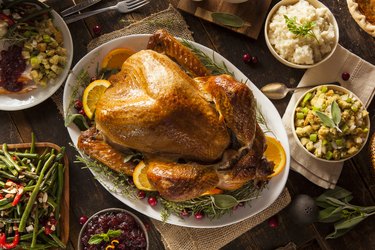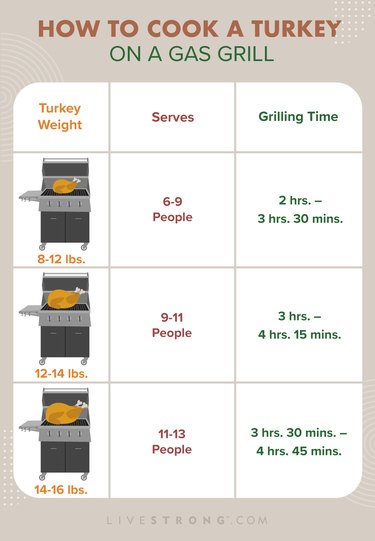
When it's time to cook a whole turkey, most of us turn to the oven. But some opt to grill their turkey. While it may require a few more steps, cooking your turkey on a Weber gas grill leads to juicy turkey meat along with crisp and well-browned skin.
Not only is it something a bit different from the typical Thanksgiving bird, but using your grill is a major win if your oven is overflowing with stuffing, potatoes and all the other classic and oh-so-important sides.
Video of the Day
Video of the Day
Here's what you need to know if you're planning to cook a turkey on a gas grill.
How to Defrost a Turkey
Plopping a turkey on the grill while it's fully or partially frozen is not advised, as it'll drastically increase the cooking time. Instead, thaw the turkey fully before cooking it on the grill.
There are only three safe ways to defrost a turkey, according to the USDA:
- In the refrigerator: This will take some time — every 5 pounds of the turkey will take 24 hours to thaw. Still, this is the most hands-off method.
- In cold water: With the turkey still in its wrapper, submerge it in cold tap water. Change out the water every 30 minutes. It takes around 30 minutes to defrost each pound of turkey.
- In the microwave: Once you've confirmed the turkey fits inside your microwave oven, follow the instructions from your microwave oven to determine the correct defrost setting. This method takes around 6 minutes per pound.
Most importantly, never thaw turkey — or any other meat — on the counter.
Food Safety
Plan ahead for a smoother grilling experience. And make sure to keep food safety in mind to avoid foodborne illness.
- Check your grill will fit the turkey. "Before you buy the turkey, you need to know the dimensions of your grill," Chef Duval Warner of Ranch 45 tells LIVESTRONG.com. Take some measurements of your grill (or take advantage of this handy chart from Weber) and then compare them to the turkey's height and width to ensure it'll fit. If your grill has a top rack, make sure it's removable so you can use the additional space, Warner says.
- Opt for the right-sized bird: A giant bird is a poor fit for grilling. Your turkey should be 16 pounds or under, per the USDA. Larger turkeys will stay in the so-called danger zone (where bacteria flourish) for too long, according to the USDA.
- Clean your grill: Check in advance to make sure your grill is in proper working condition, with all the burners working. And it should be clean, too: Avoid chemical cleaners for the grates, Warner says. Instead, he recommends using an onion — just heat up the grill so the grates get hot, then scrub a halved onion along them to remove grime.
- Get the tools you'll need: Grill tongs are essential, Warner says. Stay away from any glass or plastic materials while grilling. Make sure you have "a thermometer that has an alert for internal cooking temperatures," he adds.
- Know your temperatures: Part of the reason a thermometer is so essential is that the only way to know if a turkey is fully cooked is when its internal temperature reaches 165 degrees Fahrenheit, per the USDA. Before taking the turkey off the grill, check the temperature in three spots, according to USDA guidance: the thickest part of the breast, the innermost thigh and the innermost wing.
- Put your grill in a good spot: Keep your gas grill far from your house, deck and overhanging branches, according to the National Fire Protection Association. Plus, make sure you'll be grilling in a well-lit area (in November, around Thanksgiving, dusk arrives early).
Warning
Do not stuff a turkey that you plan on grilling, per the USDA.
Preparing the Grill
There are a few steps you'll need to take with the grill before cooking your bird.
Things You'll Need
Propane
Drip pan (or aluminum pan)
Water
Wood chips (optional)
Aluminum foil (optional)
Grill box (optional)
Step 1: Clean the grill.
Step 2: Make sure you've got a full propane tank and enough propane to cook the turkey from start to finish, Warner says.
Step 3: Prep your wood chips if you're using them. These will help give the turkey a smoky flavor. If you have a grill box, fill it with wood chips. Otherwise, create an aluminum foil packet around the wood chips, then poke a few holes in it.
Step 4: Lift the grate and put your drip pan in place, Warner says. It should go directly on the flavorizer bars and have some water within it. This will help keep your grill clean by catching any grease that drips from the bird, per the USDA.
"Also, it is good to use a drip pan as it maintains moisture in your grill," Warner says. If you do not have a drip pan, use an aluminum pan instead.
Step 5: Follow the owner's manual instructions to preheat the grill for indirect heat. This will only take about 15 minutes, Warner says. Preheat with the burners at high, and the grill's lid closed, according to the Nebraska Department of Agriculture.
Step 6: Once the grill is preheated, lower the cooking temperature to 350 degrees Fahrenheit. Turn off one of the burners entirely, which is where the turkey will go for indirect grilling.
Tip
You’ll be cooking the turkey using indirect — not direct — heat. Essentially, this means the burner directly below the turkey will be turned off, and the burners beside the bird will be on.
How to Grill the Turkey
Once the grill is preheated, you'll be ready to cook the turkey.
If you want to brine the turkey — see step 3 — you'll need to do so the day before you cook the turkey.
Things You'll Need
Turkey, thawed
Paper towels
Kosher salt (optional)
Water (optional)
Large food-safe container (large enough to fit the turkey)
Canola oil or butter
Seasonings
Roasting rack
Aluminum foil pan
Oven mitts
Internal temperature gauge probe
Wood chips packet or grill box (optional)
Step 1: Remove the turkey from its wrapping. Remove the giblets and gizzards from inside the turkey.
Step 2: Pat the turkey dry with paper towels.
Step 3 (optional): If you wish to brine the bird, do so the night before you plan to cook and eat the turkey. Mix together water and kosher salt in a ratio of 1 cup of kosher salt to one gallon of water in a large container, per instructions from the National Turkey Federation (NTF).
Place the turkey in the container — it should be fully covered by the water and salt mixture. Refrigerate the turkey in the brining mixture for at least 8 hours, according to the NTF.
Step 4: Brush the bird inside and out with canola oil or butter. "Season inside and out with your favorite seasoning," Warner says — he likes to use yellow mustard.
Step 5: Set a roasting rack inside of a large aluminum foil pan. Place the turkey on the rack, breast side up.
Step 6: Set temperature gauge probe to 165 degrees Fahrenheit and insert it into the turkey's innermost thigh.
Step 7: Once the grill is preheated to 350 degrees Fahrenheit, place the turkey pan directly over the part of the grill that is not lit and close the lid.
Step 8: Let the turkey cook, undisturbed, until the internal temperature reaches 150 degrees Fahrenheit. With this method, you do not need to flip the bird.
For a smokey flavor, add wood chips. You can place them in a grill box on top of the grates, Warner says. Or, create a smoke pack: Put the wood chips in an aluminum foil packet, then puncture it with a fork. "Place your wood box or smoke packets over the burner on the indirect side to allow the smoke to flow throughout the grill," Warner says.
Step 9: Smoke until the internal gauge reaches 165 degrees Fahrenheit. Or, if you're not adding smoke, simply cook until the internal temperature of the bird is 165 F.
Then, open the lid to the grill. Use a food thermometer to check the temperature in two other spots: the innermost part of the wing and the breast. If the temperature in all three spots is 165 degrees Fahrenheit, the turkey is done.
Remove the turkey from the grill.
Step 10: Let the turkey sit for around 20 minutes to redistribute the juices. Then carve and serve.
Tip
Avoid opening the grill! “Leave it alone to not disturb or fluctuate the cooking temperature,” Warner says.
How Long to Grill Turkey
No matter how you cook a turkey — in the oven, on the stovetop, in a slow cooker and so on — timing is an important factor. And with the grill, timing is particularly tricky.
"There are many technical and environmental factors cooking on a gas grill," Warner says. For instance, if you open up the grill to check in on the bird as it cooks, you're introducing cold air. Cold weather outside could make it harder for the grill to maintain its heat — and it takes longer to grill a turkey if it's cold out, according to the USDA.
A good rule of thumb when it comes to cooking time: One pound of turkey meat will take 15 to 18 minutes on the grill, per the USDA.
And, as a reminder, the USDA recommendation is to stick with a turkey that's 16 pounds or less.
Grill Time for a Whole Turkey by Weight
Turkey Weight | Servings | Grilling Time |
|---|---|---|
8-12 pounds | 6-9 | 2 hrs. - 3 hrs. 30 mins. |
12-14 pounds | 9-11 | 3 hrs. - 4 hrs. 15 mins. |
14-16 pounds | 11-13 | 3 hrs. 30 mins. - 4 hrs. 45 mins. |

- USDA: "How to Safely Thaw a Turkey"
- Weber: "What Size Turkey Will Fit In My Grill?"
- USDA: "If the power goes off while a turkey is roasting in oven, can I transfer it to a grill to finish the cooking?"
- USDA: "Countdown to a Food-Safe Thanksgiving Day - FAQs"
- USDA: "How to Cook a Thanksgiving Turkey"
- USDA: "Can you grill a turkey?"
- Nebraska Department of Agriculture: "Turkey Cooking Tips"
- National Turkey Federation: "Time to Brine Your Turkey"
- National Fire Protection Association: "Grilling Safely"